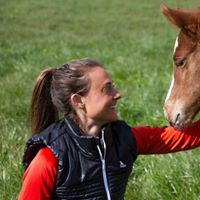Joint Injections in Horses, Preventative Measures and Joint Health with Camilla Whishaw

About Camilla
– If you would like to know more about Camilla then listen to her previous chat
First Chat (439) Camilla Whishaw
Second Chat (497) – Camilla Whishaw 2 – “Ten Important Facts About Good Gastro-Intestinal Health in Horses”
Third Chat (585) Camilla Whishaw 3 – “Ten Important Considerations (And Myths to Bust) For The Best Use Of Supplements”
Fourth Chat (724) – Camilla Whishaw 4 – “Ten Considerations for the Horse with Ulcers”
Fifth Chat (873) – Camilla Whishaw 5 – Equine Asthma & Respiratory Health Explained with Camilla Whishaw
Sixth Chat (927) – Camilla Whishaw 6 – Equine Anxiety, Stress and Behavioural Issues. Camilla Whishaw discusses the role that diet and supplements play
About This Episode
Joint Injections in Horses, Preventative Measures and Joint Health with Camilla Whishaw
To Listen to Camilla Whishaw 7 on YouTube – Click Here
To Listen to Camilla Whishaw 7 on iTunes – Click Here
Or Listen below
Joint Injections in Horses, Preventative Measures and Joint Health with Camilla Whishaw
JOINT HEALTH IN HORSES AND PONIES
The role of diet, management, supplement and medications in equine joint health
1) What is joint health?
- Orthopaedic soundness in horses and ponies
- Joint structure and function
- Different types of joints in horses
- Structure and function of synovial joints
2) What role does gastrointestinal health play in joint health?
- For detailed discussion on gastrointestinal health in horses, listen to Listener’s Choice Chat 0959 with Camilla Whishaw.
- Gastrointestinal (GI) microbiota can influence joint health.
- Imbalances (dysbiosis) in gut microflora can increase inflammation in joints; disrupt bone metabolism; decrease quality and viscosity of synovial fluid in joints and reduce the absorption and metabolism of key nutrients needed for good bone and joint health.
- What we feed our horses, and medications they receive, stress levels, etc can all impact their GI microbiome and in turn effect joint health.
3) What role does diet play in joint health?
- Diet that promotes a healthy GI microbiome; meets key nutritional requirements appropriate for the individual horse; and helps to maintain a healthy body weight and body composition in our horse.
- Anti-inflammatory diet
- Essential nutrients for bone and joint health
- Diet should contain a minimum of 1.5% of our horse’s body weight in dry matter fibre daily.
- Keep hard feed/meal sizes small
- The temptation to use supplements without first addressing diet in horse or pony.
- Awareness that many commonly used medications in horses impact nutrient digestion, absorption, excretion and/or metabolism.
4) Supplements for joint health
- Different supplements work through different mechanisms of action: bone health; cartilage integrity; synovial fluid quality; ligament and tendon integrity.
- Examples of some of the many different herbs and nutrients commonly supplemented for joint health.
- Factors which influence the suitability and choice of supplementation for each individual horse: nutrient or herbal medicine form; dose; bioavailability; co-factors; duration of supplementation; medications a horse may be on; age of horse; competition horses.
- What are we trying to achieve with supplementation?
- Oral supplementation is only as good as a horse or pony’s GI health.
- For more detailed conversation on the appropriate use of supplementation in horses, listen to chat: (585) Camilla Whishaw 3– “Ten Important Considerations (And Myths to Bust) For The Best Use Of Supplements”
5) What effects does exercise have on joint health?
- Role of ‘informal’ V ‘formal’ exercise
- Role of turnout of young horses in relation to bone, tendon, ligament and joint health.
- Effects of spelling/turning a horse out on bone and joint health.
- Gradually bringing horses back into work after spelling/extended turnout.
- Special considerations in relation to longeing horses.
- Exercise and growth plates in young horses.
6) How does body weight and condition influence joint health?
- The more body weight a horse carries, the more wear and tear through their joints.
- 60-70% of a horse’s body weight goes through their front legs.
- At certain phases of the gallop, up to 2.5% of a horse’s bodyweight can go through one leg.
- Adipose (fat) tissue acts as an endocrine organ, producing inflammatory mediators.
- The more adipose tissue a horse has, the more inflammatory mediators it produces: influencing cartilage degeneration and reducing synovial fluid quality.
7) Can you talk about joint health across the different life stages in horses?
- Young horses: key considerations are developmental orthopaedic diseases.
- Osteochrondritis Dissecans (OCDs): most commonly in Thoroughbreds and Warmbloods
- Older horses, particularly those worked hard in early years of life: more likely to have degenerative joint conditions such as osteoarthritic changes.
8) Can you talk a little about joint injections in horses?
- Different types of joint injections: Intravenous (IV); intramuscular (IM); intra-articular (IA)
- Different agents used in joint injections: Sodium pentosan polysulfate; glycosaminoglycan polysulphate; hyaluronate sodium; corticosteroids; antibiotics
- Risks associated with IA joint injections
- Questions to consider: What substances are we injecting? Why are we injecting them? Have we adequately addressed all other influencing factors?
9) Are there any other factors which play a significant role in joint health
- Assess an address the needs of the individual horse
- Consider role of trimming and/or shoes; hoof angles; break over; horse’s conformation; biomechanics; loading patterns.
- Fitting of saddle, bit and tack.
Camilla’s Contact Details
Phone: 0499 256 316 or +61 499 256 316
Email: camilla@optimequine.com
Website: www.optimequine.com
Facebook: Optim Equine
Instagram: Optim Equine
Music
BenSound.com
When Camilla is a return guest on Horse Chats, what question would you like to ask her?
(Please leave comment below)
Leave a Reply